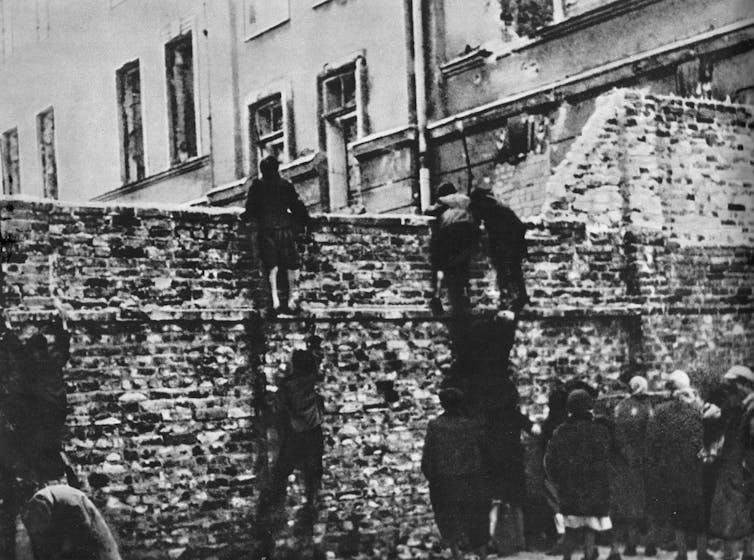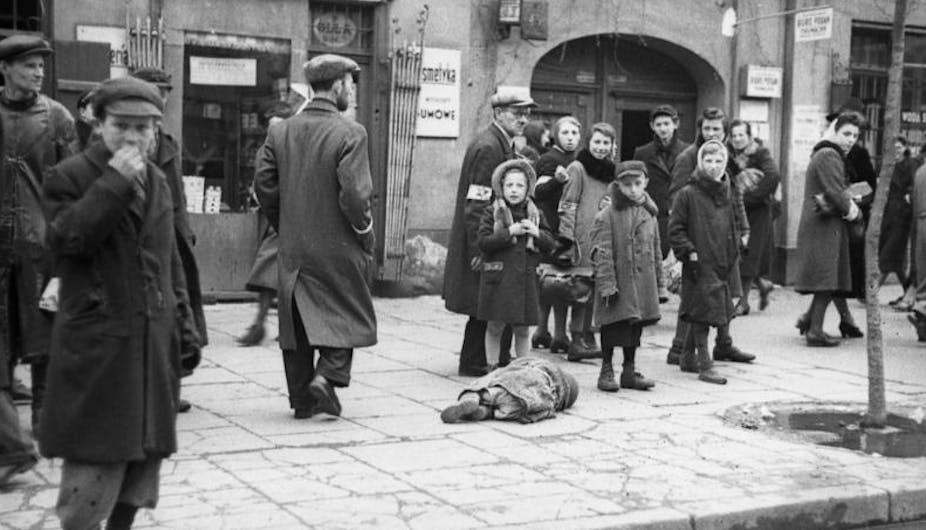Warsaw Ghetto Uprising
"Photographs depicting the smoke over the ghetto as well as in the streets and courtyards inside the ghetto, burnt-out houses, firefighters putting out the flames, posing on the roof of a building or eating from mess tins in the street.""It seems that Leszek Grzywaczewski tried his best to record these scenes, realizing the importance of documenting events inaccessible to the eyes of people on the other side of the ghetto wall."POLIN Museum of the History of Polish Jews, Warsaw"The Germans began to systematically burn down the buildings, turning the ghetto into a fire trap." "The Jews fought valiantly for a month until the Germans took over the focal points of resistance.""It was the first popular uprising in a city in Nazi-occupied Europe."Yad Vashem, World Holocaust Remembrance Center, Israel
![Children eating in the ghetto streets. Warsaw, Poland, between 1940 and 1943. [LCID: 89473]](https://encyclopedia.ushmm.org/images/large/f4f2a264-e6bd-4f86-b175-9d0108693a9d.jpg) |
| USHMM Warsaw, Poland, between 1940 and 1943 |
On October 12, 1940, German military authorities occupying Poland decreed establishment of a ghetto
in Poland's capital, Warsaw. The decree required all Jewish residents of the city to move
into a designated area sealed from the
rest of the city. The ghetto was enclosed by a wall 10 feet in height capped by barbed wire, closely guarded
to prevent movement between the ghetto and the rest of Warsaw.
The
population of the ghetto was increased with Jews compelled to move there from
nearby towns, the final total of ghetto residents estimated to be over 400,000. Ghetto residents were forced to live in an area of 1.3 square miles, equal to an
average of 7.2 persons per room. Food was scarce and hunger was rampant.
Some young men and women ventured out of the ghetto over the walls at night or through underground sewer tunnels, to bring back outside news, to return with food, and eventually some joined the Polish Underground movement. Others brought back whatever weapons they could find. Over time a cache of weapons was built representing the armoury put to use in time by the resisters of the Warsaw Ghetto. Comprised mostly of young Jews who resolved to fight and to die in the effort. And they did -- accomplishing both goals.
Photographs of the period have been placed at various memorial sites; mostly photographs taken for recording purposes by German forces, addicted to record-keeping and maintenance. As though proud of their accomplioshments and determined to ensure a precise accounting of all measures taken in the extermination of Europe's Jews. To indicate how efficient and proficient they were, tasked by their Fuhrer to rid the world of the presence of Jews.
 |
A newly discovered cache of personal photographs, the property of a young Polish firefighter of the time, highlights the destruction the Nazis brought to the tight little enclave where Jews were fenced in, many dying of disease or starvation. When the German military became aware of a planned uprising they must have been astonished that a paltry few ill-equipped Jews had the temerity to fight back, and in fact manage to counter an offensive and keep the Germans at bay for a month; a rag-tag, starving group of Jews countering the mighty German military.
The German authority had begun slowly selecting Jews for deportation to the Treblinka extermination camp wth its goal to "eliminate the Jewish population". An estimated 265,000 Jews were deported from July to September of 1942, wth another 35,000 killed outright in the ghetto itself. This brought Jewish resistance groups to plan a response. The illusion that anyone would survive the ghetto when the war eventually came to an end dissipated as the ghetto incarcerants began to realize they were all slated for death.
 |
| Starvation was omnipresent in the Warsaw Ghetto for both young and old. Blid Bundesarchiv/Wikimedia Commons, CC BY-SA |
The Warsaw Ghetto Uprising was sparked by the evacuation of Jews to certan death. During the final days of the uprising the Nazis ended the Jewish resistance by setting the ghetto on fire. The German military called on Warsaw firefighters to make certain the blaze "did not spread to the houses on the 'Aryan' side", according to the POLIN Museum, located on the site of the former Warsaw Ghetto.
A yuung Zbigniew Leszek Grzywaczewski, 23 years of age, began snapping pictures while pursuing his duties as a civilian firefighter. Images show buildings on fire, smoke billowing, firefighting crews and Jews evacuated from the ghetto. The photographs, since the negatives were found by a son of the photographer, represent the sole known photos taken by a non-German.
A dozen of the 48 shots on the roll of negatives were published previously as prints, held at the Holocaust Museum in Washington and the Jewish Historical Institute. The POLIN Museum now possesses photographs never before seen. The negatives are now to be featured in an exhibition titled "Around Us a Sea of Fire" in honour of the Warsaw Ghetto Uprising's 80th anniversary, at the POLIN Museum.
![Jews captured during the Warsaw ghetto uprising. Poland, April 19-May 16, 1943. [LCID: 46432]](https://encyclopedia.ushmm.org/images/large/03b894f9-0816-4efd-85a0-3590fe17e376.jpg) |
Labels: Holocaust, Nazi Occupation of Poland, Photographs, Warsaw Ghetto Uprising, World War II
0 Comments:
Post a Comment
<< Home